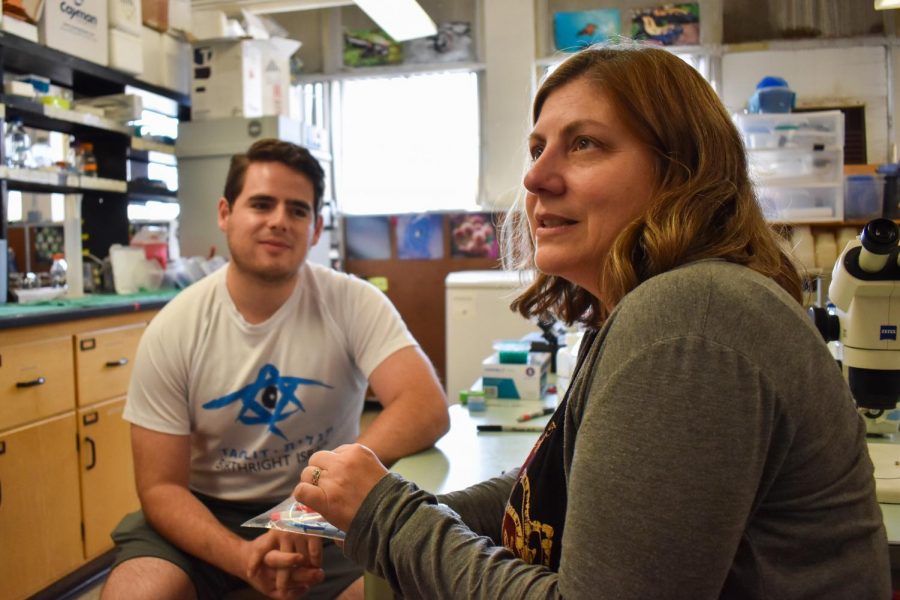Researchers rear threatened species of frog
University to release 120 frogs at the end of the month
EMMA LEDBETTER | THE DAILY EVERGREEN
Professor Erica Crespi explains how Northern Leopard frogs are facing habitat destruction in the northwest United States Friday afternoon in Heald Hall. Crespi says a number of factors can lead to declining populations, including disease, dams and housing developments.
August 19, 2019
In an effort to reintroduce the Northern Leopard frog in Washington state, WSU researchers have been raising frogs to release them into the wild.
Tadpoles were reared at WSU in artificial ponds that were partly designed and implemented by Erica Crespi, assistant professor in the school of biological sciences.
More frogs die as tadpoles than during any other stage of their lives, which is why the project revolved around raising the tadpoles in a safe environment free from the predators and pathogens they might encounter in the wild, Crespi said.
“We’re kind of giving these larvae a really safe environment in which to live and grow and develop,” Crespi said.
After raising tadpoles in the artificial pond, researchers moved the frogs into the lab. Then they recorded how long it took the frogs to go through metamorphosis, the stage starting when the frogs’ legs become visible and ending when their tails fully recede into their bodies, said Bernie Traversari, a graduate student in the school of biological sciences.
Traversari said that Allan Pessier, clinical associate professor in the Washington Animal Disease Diagnostic Laboratory, checked for infectious diseases in the frogs that died.
Crespi said that Caren Goldberg, assistant professor in the school of the environment, is involved in the research. She will assess the genetic variation of the released frogs.
This project is a collaboration between WSU, the Oregon Zoo, the U.S. Fish and Wildlife Service, and the Washington Department of Fish and Wildlife, Crespi said.
Traversari said the Oregon Zoo raised the frog eggs and realized it could not take care of all the frogs, so some frogs were transported to WSU.
Northern Leopard frogs have been in decline in the Pacific Northwest since the 1980s, Traversari said.
Crespi said invasive species, like the bullfrog, eat Northern Leopard frogs. Habitat destruction has also contributed to the decline of the species.
It has not been confirmed, but it is possible that pathogens, like ranavirus, have also caused the species to decrease in number because they have done so to other frog species, Crespi said.
While the last Northern Leopard frog population in Washington state lives in Potholes Reservoir, the reintroduction project releases the frogs in the Columbia National Wildlife Refuge, Crespi said.
The refuge is managed by the U.S. Fish and Wildlife Service.
The frogs are transported to the refuge and placed into a mesh enclosure for approximately one day to acclimate to the habitat of the refuge, Crespi said.
WSU has released 152 frogs so far. Some frogs developed slower than others, so they will be releasing about 120 frogs at the end of the month.
The project is funded through a grant provided by the U.S. Fish and Wildlife Service to the Washington Department of Fish and Wildlife.
“We’re hoping that this project helps build a healthy population here,” Crespi said, “and keeps the Northern Leopard frog in Washington State.”











Melinda Johnson • Aug 21, 2019 at 8:32 pm
Just wanted to thank you for doing your part to help ensure that frogs are still around. I have heard a lot of negative information about the frog population worldwide. This positive news is music to my ears.